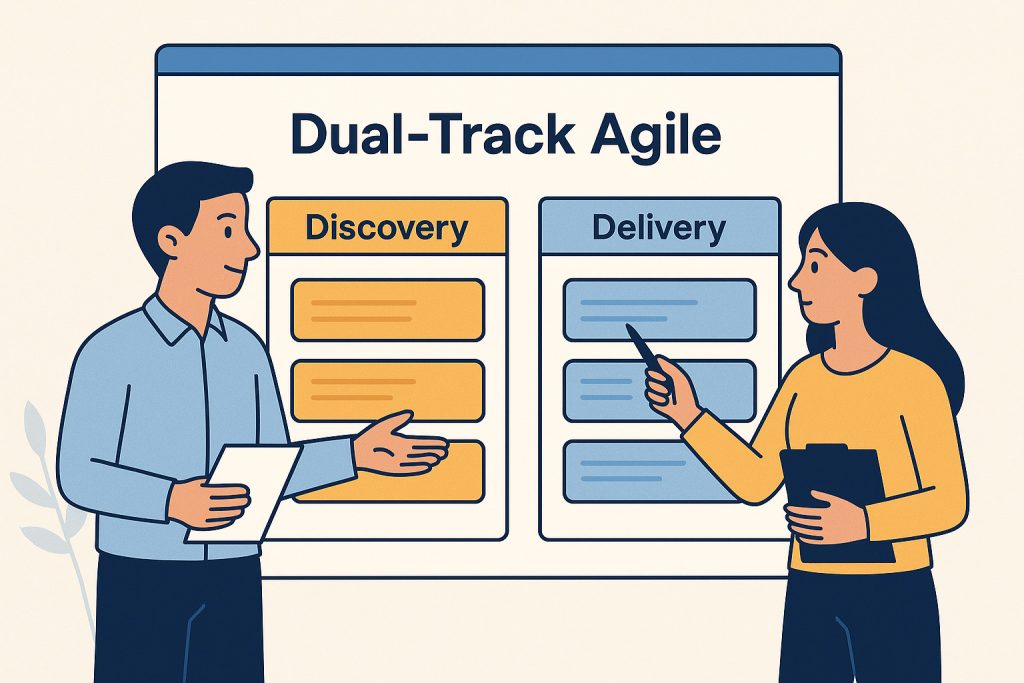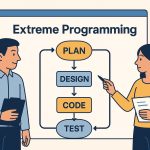Product teams today face an increasingly complex challenge: how do you move fast without breaking things? How do you innovate while ensuring every feature you build actually matters to users? Traditional agile methodologies promised to solve these problems, yet many teams still find themselves caught in what Marty Cagan from Silicon Valley Product Group calls “little mini-waterfalls”—linear handoffs disguised as agile practice.
Enter dual-track agile, a methodology that fundamentally reimagines how product teams organize their work. Rather than treating discovery and delivery as sequential phases, this approach runs them in parallel, creating a more dynamic and responsive development process that can dramatically improve both the speed and quality of product development.
What is Dual-Track Agile?
At its core, dual-track agile represents a shift in how cross-functional product teams structure their daily work. Instead of following a single development track, teams split their efforts into two concurrent streams: discovery and delivery. This isn’t simply about dividing labor—it’s about recognizing that learning and building should happen simultaneously, feeding into each other in a continuous cycle of improvement.
The discovery track serves as the team’s research and validation engine, focusing on generating and validating product ideas before they consume precious development resources. Meanwhile, the delivery track transforms those validated concepts into market-ready software. What makes this approach powerful is that these tracks don’t operate in isolation; they’re designed to inform and enhance each other throughout the development process.
This parallel structure addresses a fundamental flaw in how many agile teams operate. Even within short sprints, teams often fall into predictable patterns: product managers define requirements, designers create wireframes, and developers build features. While this might feel agile, it’s essentially a compressed waterfall approach that limits collaboration and increases the risk of building features that miss the mark.
How Does Dual-Track Agile Work?
The beauty of dual-track agile lies in its embrace of non-linear collaboration. Rather than requiring complete specifications before development begins, this methodology allows discovery and delivery to evolve together. Product managers, designers, and developers work as an integrated unit across both tracks, sharing insights and adjusting course based on what they learn.
This collaborative approach fundamentally changes team dynamics. Discovery findings immediately influence delivery decisions, while development challenges can reshape discovery priorities. The result is a more responsive development process that adapts quickly to new information rather than rigidly following predetermined plans.
The methodology also recognizes that different types of work require different timelines and approaches. While delivery work often follows predictable sprint cycles, discovery work might involve longer research phases or rapid experimentation bursts. By running these tracks in parallel, teams can optimize each type of work without forcing artificial constraints.
3 Reasons to Use Dual-Track Agile
Better products
When validation becomes a prerequisite for backlog entry, product quality improves dramatically. Teams using dual-track agile don’t just build features—they build features that have already demonstrated value through research, user feedback, or market validation. This shift from assumption-based to evidence-based development significantly increases the likelihood that released features will resonate with users and drive business outcomes.
The improvement goes beyond individual features. By maintaining a constant discovery process, teams develop a deeper understanding of their users’ evolving needs and market dynamics. This ongoing insight helps inform not just what to build, but when and how to build it.
Less wasted time
Traditional development approaches often require multiple iterations to get features right with users. Teams build something, release it, gather feedback, and then rebuild. Dual-track agile front-loads this learning process, using the discovery track to identify potential issues and opportunities before significant development resources are committed.
This doesn’t eliminate iteration—it makes iteration more strategic. When teams do need to adjust course, they’re working with validated assumptions and clearer success criteria, making changes more targeted and effective.
Lower development costs
The parallel nature of dual-track agile creates multiple cost advantages. Development velocity increases because both tracks can make progress simultaneously rather than waiting for sequential handoffs. Teams don’t experience the idle time that often occurs when one group finishes their work while another is still in progress.
More importantly, the validation requirements of the discovery track prevent teams from pursuing expensive development projects that haven’t proven their worth. This filtering mechanism ensures that development resources focus on initiatives with demonstrated potential rather than untested ideas that might fail in the market.
How Does Dual-Track Agile Development Work?
Implementation of dual-track agile involves establishing clear but flexible processes for both tracks while maintaining strong communication between them.
The discovery track typically includes:
- Stakeholder interviews to understand business needs and constraints
- Persona development and user story creation based on actual user research
- Comprehensive market research including surveys, user interviews, and competitive analysis
- Validation processes that move promising ideas onto the delivery team’s backlog
The delivery track focuses on:
- Prototype development, from wireframes to functional demos
- Iterative user testing to refine and improve solutions
- Applying user feedback to create polished, market-ready products
The key to success lies in maintaining overlap and communication between these tracks. Discovery insights should immediately inform delivery decisions, while delivery challenges should influence discovery priorities. Cross-functional team members need visibility into both tracks to prevent misalignment and ensure everyone understands how their work contributes to the larger goals.
Regular synchronization points help maintain this alignment. Many teams use brief daily standups that cover both tracks, weekly cross-track reviews, and sprint planning sessions that consider discoveries and delivery capacity together. The goal is to maintain the parallel nature of the work while ensuring both tracks remain coordinated and mutually supportive.
At its heart, dual-track agile represents a maturation of agile thinking, moving beyond process mechanics to embrace the underlying principles of collaboration, learning, and adaptation. It acknowledges that modern product development is inherently complex and requires approaches that can handle uncertainty while maintaining momentum. By running discovery and delivery in parallel, teams create a more resilient development process that can respond to changing requirements without losing sight of user needs or business objectives. The methodology doesn’t just make teams faster—it makes them smarter about how they use their speed.
Conclusion
Dual-track agile offers more than just another development methodology—it provides a framework for thinking differently about how product teams create value. By breaking down the artificial barriers between discovery and delivery, teams can build products that are both technically excellent and genuinely useful to their users. In a world where the cost of building the wrong thing continues to rise, this approach offers a path toward more thoughtful, effective product development that serves both business objectives and user needs.


